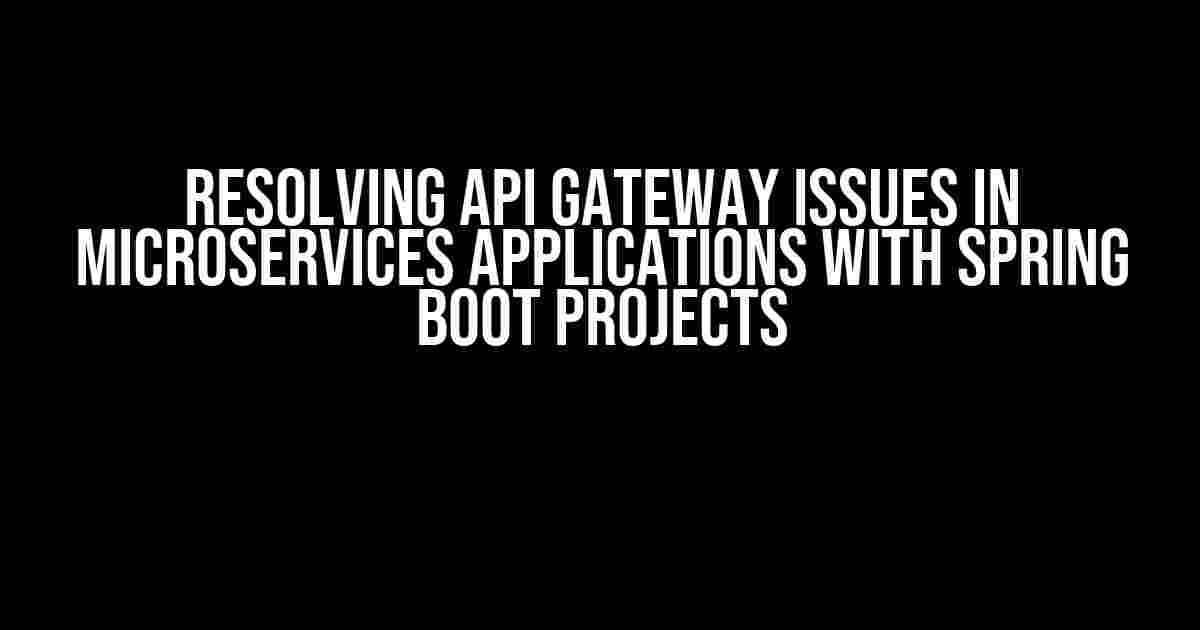When building microservices applications using Spring Boot projects as individual services, it’s not uncommon to encounter issues with accessing business services through the API gateway. This article aims to provide a solution to this problem, ensuring seamless communication between services and the API gateway.
Understanding the Problem
In a microservices architecture, each service is designed to be independent and self-contained, communicating with other services through APIs. However, when using an API gateway as the entry point for clients, it’s essential to configure the gateway correctly to route requests to the appropriate service.
If not properly configured, the API gateway may not be able to access the business service, resulting in errors and failed requests. This can be frustrating, especially when each individual service is functioning correctly.
Causes of the Issue
There are several reasons why the API gateway may not be able to access the business service in a microservices application with Spring Boot projects. Some common causes include:
- Incorrect configuration of the API gateway
- Invalid service discovery setup
- Incorrect routing configurations
- Security configurations blocking access to the service
- Service registration issues with the service registry
Resolving the Issue
To resolve the issue of not being able to access the business service through the API gateway, follow these steps:
-
Verify API Gateway Configuration
Review the API gateway configuration to ensure it is correctly setup to route requests to the business service. Check the gateway’s routing configuration, service discovery setup, and security settings.
-
Check Service Registration
Verify that the business service is correctly registered with the service registry. Ensure the service is registered with the correct hostname, port, and context path.
-
Validate Service Discovery
Confirm that service discovery is correctly configured to enable the API gateway to find the business service. Check that the service discovery mechanism (e.g., Eureka, Zookeeper, or Consul) is properly setup and functioning.
-
Review Routing Configurations
Check the routing configurations in the API gateway to ensure they are correctly routing requests to the business service. Verify that the routing rules, predicates, and filters are correctly defined.
-
Debug and Test
Enable debug logging in the API gateway and business service to identify any errors or issues. Use tools like Postman or cURL to test the API gateway and business service directly to isolate the problem.
Conclusion
In conclusion, resolving issues with accessing business services through the API gateway in microservices applications with Spring Boot projects requires a systematic approach. By verifying the API gateway configuration, checking service registration, validating service discovery, reviewing routing configurations, and debugging and testing, you can identify and resolve the root cause of the issue.
By following these steps, you can ensure seamless communication between services and the API gateway, enabling your microservices application to function as intended.
Frequently Asked Question
Get the answers to the most commonly asked questions about accessing business services using an API gateway in a microservices application with Spring Boot projects.
Q1: Why can’t I access my business service using the API gateway?
A1: This might be due to incorrect API gateway configuration or service registration. Check your API gateway configuration to ensure it’s correctly routing requests to your business service. Also, verify that your business service is registered with the service registry, such as Eureka or ZooKeeper.
Q2: How do I configure my API gateway to route requests to the correct business service?
A2: You can configure your API gateway using routing mechanisms like Spring Cloud Gateway’s RouteLocator or Zuul’s route configuration. Define routes that map incoming requests to specific business services based on URLs, headers, or other criteria.
Q3: What are some common mistakes to avoid when configuring API gateway routes?
A3: Common mistakes include misconfiguring route paths, forgetting to enable SSL termination, or neglecting to add necessary headers or query parameters. Double-check your configuration to avoid these mistakes and ensure smooth routing to your business services.
Q4: Can I use a service discovery mechanism to dynamically route requests to my business services?
A4: Yes, you can use service discovery mechanisms like Eureka, ZooKeeper, or Consul to dynamically discover and route requests to your business services. This approach allows for more flexibility and scalability in your microservices architecture.
Q5: How do I troubleshoot issues with API gateway routing to my business services?
A5: Use logging and tracing tools like Spring Boot’s Actuator, Logback, or OpenTracing to monitor and debug requests flowing through your API gateway. Enable debug logs to inspect request and response details, and use tools like Postman or cURL to test your API gateway routes.

